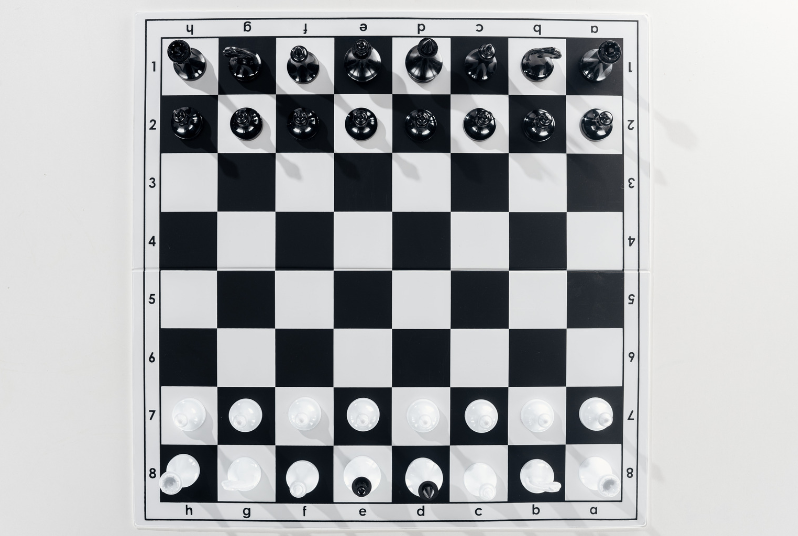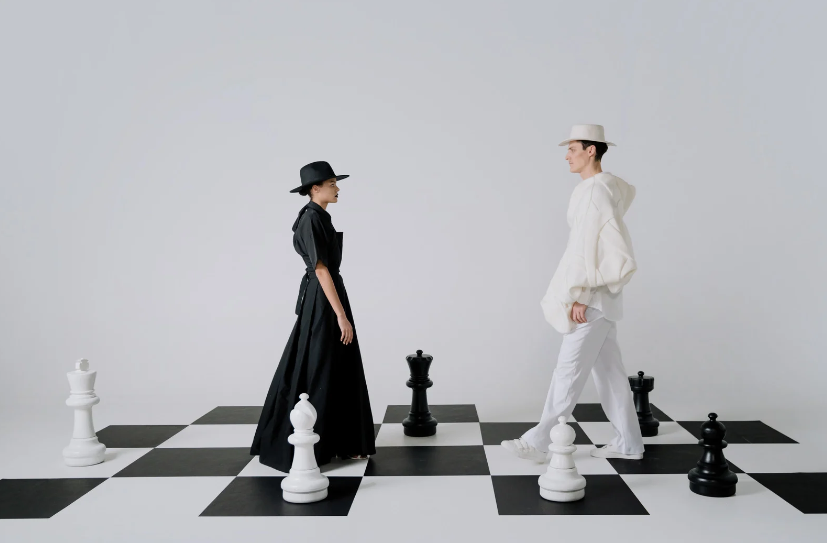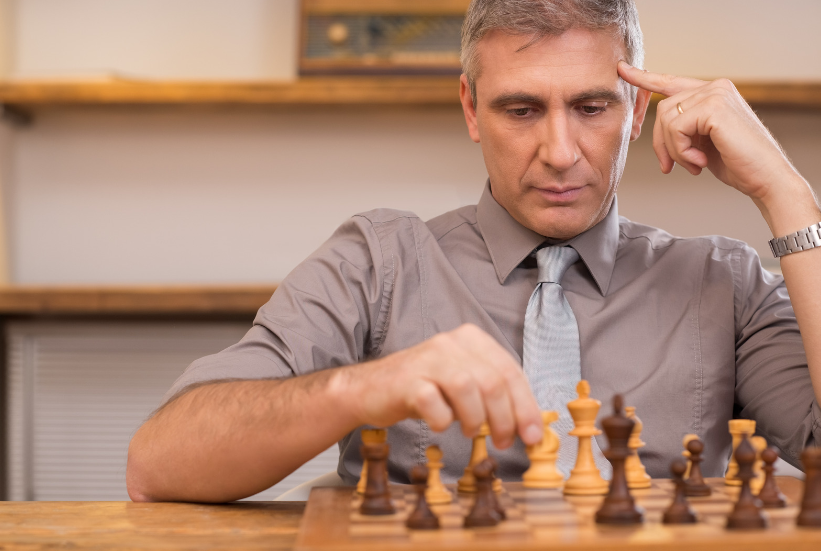How to Set Up a Chessboard. Chess is a timeless game that has captivated people for centuries with its strategic depth and intellectual challenges. If you’re new to chess or need a refresher on how to set up a chessboard, this article will guide you through the process of how to set up a chessboard step by step. Chess is a great game to improve your critical thinking skills.
By the end, you’ll be ready to embark on your chess journey and engage in thrilling battles on the checkered battlefield.
Related Topic: How To Improve Memory and Concentration
Basics of Chessboard
Understanding chessboard basics will help you to improve your chess rating. How to Set Up a Chessboard. Let’s understand the basics of the chessboard. The chessboard consists of a square grid composed of 64 alternating dark and light-colored squares.
It is an 8×8 board, with eight ranks (rows) and eight files (columns). Each square on the board has a unique coordinate, indicated by a combination of a letter and a number.
Understanding the ChessBoard
The first thing first to know how to set up a chessboard is to understand the layout of the chessboard.
Chess Board Dimensions
The standard chess board is a square measuring 8×8, with a total of 64 squares. We label the eight ranks from 1 to 8, starting from the bottom and moving up. We labeled the eight files from A to H, starting from the left and moving right.
Chess Board Squares and Colors
The chessboard is made up of alternating dark and light-colored squares. The traditional colors are black and white, we can find although different combinations in themed sets. The board’s colors help players distinguish between different squares and aid in visualizing strategies.
Setting Up the ChessBoard

How to Set Up a ChessBoard. To set up a chessboard, you need to place the chess pieces correctly and ensure the proper orientation.
Placing the Chess Pieces
The chess pieces consist of two opposing armies: white and black. Each army has 16 pieces, including a king, a queen, two rooks, two knights, two bishops, and eight pawns. We place the pieces on the board at the beginning of the game.
Orientation of the Chess Board
Before setting up the pieces, it’s essential to ensure that the board is oriented correctly. The bottom-right corner square must be a light-colored square. With the right orientation, both players will have a light-colored square on their right-hand side.
Understanding the Chess Pieces
To set up the chessboard correctly, it’s crucial to understand the role and initial placement of each chess piece.
King and Queen
The king is the most critical piece in chess. It starts on the e-file in the initial setup and is denoted by the symbol “K.” The queen, the king’s powerful counterpart, starts on the adjacent square and is denoted by “Q.”
Rooks, Knights, and Bishops
The rooks, also known as castles, start at the corners of the board. They are denoted by “R” and are positioned at a1, a8, h1, and h8. Knights, represented by “N,” occupy the squares next to the rooks. Finally, the bishops, marked as “B,” are placed next to the knights.
Pawns
It’s from the front line of defense. They are represented by no symbol and occupy the second rank for each army.
Read More: How To Improve Self-Esteem and Self-Confidence
The Initial Chess Board Setup
Essential chessboard Setup Guide Get all the details you need to properly set up a chessboard for an enjoyable gaming experience. Before we delve into the step-by-step guide, let’s take a moment to appreciate the visual representation of the initial chessboard setup. This setup forms the foundation for every chess game.
Step-by-Step Guide to Setting Up a ChessBoard

Learn How to Set Up a Chess Board Discover the step-by-step process of setting up a chess board and preparing for a thrilling game. Let’s go through the process of setting up a chessboard, ensuring that each piece is correctly placed.
Step 1: Placing the Rooks
The rooks, the towers of the army, are placed on the corners of the board. Put the white rooks on squares a1 and h1, and the black rooks on a8 and h8.
Step 2: Placing the Knights
Next, position the knights beside the rooks. The white knights go on squares b1 and g1, while the black knights occupy b8 and g8.
Step 3: Placing the Bishops
Place the bishops next to the knights. The white bishops take squares c1 and f1, and the black bishops take c8 and f8.
Step 4: Placing the Queen
Position the queen on the remaining square of her color. The white queen goes on d1, while the black queen occupies d8.
Step 5: Placing the King
Finally, place the king beside the queen. The white king takes square e1, and the black king takes e8.
Step 6: Placing the Pawns
The pawns occupy the second rank in each army. Place the eight white pawns on rank 2, and the eight black pawns on rank 7.
Tips for Setting Up the ChessBoard
Before we conclude, here are a few tips to ensure a smooth and accurate chessboard setup:
- Clearing the Board: Before setting up a new game, make sure to remove any pieces from a previous game to avoid confusion.
- Checking the Correct Placement: Double-check the placement of each piece according to the step-by-step guide to avoid errors.
Easy Chess Board Assembly Instructions
Assembling a chessboard is a straightforward process that can be completed in a few simple steps. Here’s a guide to help you assemble your chessboard quickly and correctly:
- Begin by placing the board on a flat surface, ensuring that the darker square is positioned in the bottom right corner.
- Take the rooks and place them on the corners of the board. The rooks are the taller pieces with a castle-like appearance.
- Next, place the knights beside the rooks. Knights are pieces shaped like horses.
- Position the bishops next to the knights. Bishops are taller pieces with pointed tops.
- Place the queen on the remaining square of her color. The queen is the taller and more elaborate piece.
- Finally, position the king beside the queen. The king is slightly shorter than the queen but equally important.
- Once the back row is complete, place the eight pawns in front of the other pieces. Pawns are smaller and less elaborate pieces.
Congratulations! You have successfully assembled your chessboard. Double-check the placement of the pieces to ensure accuracy before starting your game.
Beginner’s Guide to Chess Rules
If you’re new to chess, understanding the basic rules is the first step toward becoming a skilled player. Here’s a beginner’s guide to the fundamental rules of chess:
- The game starts with both players having 16 pieces each, positioned as described in the previous section.
- Players take turns moving their pieces. White moves first, followed by Black, and the turns alternate throughout the game.
- Each piece moves in a specific way:
- The king can move one square in any direction.
- The queen can move horizontally, vertically, or diagonally across the board.
- Rooks move horizontally or vertically.
- Knights move in an “L” shape, jumping over other pieces.
- Bishops move diagonally.
- Pawns move forward one square, but on their first move, they can choose to move two squares forward. Pawns capture diagonally.
- The objective of the game is to checkmate your opponent’s king. This means placing the opponent’s king under attack in such a way that it cannot escape capture.
- Other important rules include:
- Castling: A move where the king and one of the rooks are moved simultaneously. It provides safety for the king and connects the rooks.
- En passant: A pawn capturing an opponent’s pawn under specific conditions.
- Promotion: When a pawn reaches the opposite side of the board, it can be promoted to any other piece except a king.
By grasping these basic rules, you’ll be ready to start playing chess and exploring more advanced strategies.
Mastering Chess Opening Strategies
The opening phase of a chess game sets the tone for the entire match and greatly influences your chances of success. Here are some key opening strategies to consider when mastering chess:
- Control the center: Occupying and controlling the central squares of the board (e4, e5, d4, and d5) is a fundamental opening principle. It allows your pieces to have maximum mobility and provides strategic advantages.
- Develop your pieces: Efficient piece development is crucial in the opening. Move your pawns to open lines for your bishops and knights to enter the action. Aim to develop your pieces harmoniously and avoid unnecessary pawn moves in the early stages.
- Safeguard your king: Castling early is generally advisable, as it helps protect your king and connect your rooks. Kingside castling (O-O) involves moving the king two squares toward a rook, while queen side castling (O-O-O) involves moving the king toward the other rook.
- Be mindful of pawn structure: Your pawn structure affects your long-term strategic options. Avoid creating pawn weaknesses that can be exploited by your opponent. Maintain pawn flexibility and consider pawn breaks to gain control or create imbalances.
- Study popular openings: Familiarize yourself with various chess openings and their key ideas. Some well-known openings include the Italian Game, the Sicilian Defense, the Ruy Lopez, and the French Defense. Understanding the principles behind these openings will give you a head start in your games.
- Analyze and learn from grandmaster games: Studying games played by experienced grandmasters can deepen your understanding of opening strategies. Analyze their moves, plans, and tactics to gain valuable insights and improve your own gameplay.
Proven Chess Strategy Tips
Chess strategy encompasses a wide range of concepts and techniques. Here are some proven tips to enhance your strategic thinking and improve your overall gameplay:
- Evaluate the position: Continuously assess the position to identify strengths, weaknesses, and potential threats. Consider factors such as piece activity, pawn structure, king safety, and control of key squares.
- Plan ahead: Develop a clear plan based on the position and your long-term goals. Your plan should involve coordinating your pieces, improving their activity, and identifying potential targets.
- Calculate variations: Evaluate tactical possibilities by calculating potential moves and their consequences. Look for combinations, threats, and sacrifices that can give you an advantage or disrupt your opponent’s plans.
- Understand pawn structure: The pawn structure has a significant impact on strategy. Study different types of pawn structures and learn how to exploit their strengths and weaknesses. Recognize when to initiate pawn breaks or when to create weaknesses in your opponent’s pawn structure.
- Develop a balanced position: Aim for harmonious coordination of your pieces, ensuring they support each other and have optimal squares to operate from. Avoid overextending or overcrowding your forces.
- Study endgame principles: Even in the opening and middle game, understanding basic endgame principles is valuable. Familiarize yourself with concepts such as king and pawn endgames, piece activity in simplified positions, and key endgame techniques.
- Learn from your games: Review your own games to identify areas for improvement. Analyze both wins and losses to understand your decision-making process and identify patterns or mistakes that can be corrected.
10 Expert Tips on How to Be Grandmaster in Chess

To become a Grandmaster in chess, you will need to dedicate a significant amount of time and effort to studying and improving your problem solving skills. Here are some steps you can take to pursue the title of Grandmaster:
- Learn the basics: Start by familiarizing yourself with the rules of chess and the basic principles of the game.
- Play regularly: Find opportunities to play chess regularly, both online and offline. Practice is essential for improving your skills and gaining experience.
- Study chess theory: Invest time in studying chess theory and understanding various opening systems, middle-game strategies, and endgame techniques.
- Solve puzzles and tactics: Work on solving chess puzzles and tactics regularly. This helps sharpen your tactical awareness and calculation skills, which are crucial for becoming a strong player to increase brain capacity and power.
- Analyze your games: After playing games, review them to identify your mistakes, missed opportunities, and areas for improvement.
- Play against stronger opponents: Challenge yourself by playing against stronger opponents.
- Study endgames: Focus on studying different types of endgames, as they often have specific techniques and patterns.
- Participate in tournaments: Start participating in local and regional chess tournaments. This will provide valuable experience, expose you to different playing styles, and help you earn official rating points.
- Achieve rating milestones: Chess ratings are awarded by various organizations, such as FIDE (World Chess Federation). Aim to achieve specific rating milestones, such as Candidate Master (2200+ rating), FIDE Master (2300+ rating), International Master (2400+ rating), and eventually, Grandmaster (2500+ rating).
- Seek professional coaching: Consider working with a skilled chess coach or trainer who can guide you in your development, identify weaknesses, and provide personalized training plans.
Read More: How To Improve Interpersonal Skills
Conclusion
Congratulations! You’ve successfully learned how to set up a chessboard. With this knowledge, you’re ready to start playing and exploring the vast world of chess. Remember, the initial setup is just the beginning, and countless possibilities await you on the checkered battlefield.
FAQs
Yes, the initial setup is standard, but you can modify it in variants like Chess960 or Fischer Random Chess.
Proper orientation ensures both players have a light-colored square on their right, making it consistent for notation and strategy.
If the setup is incorrect, it could lead to an unfair advantage or confusion during gameplay. Double-checking ensures a fair start.
While traditional boards have black and white squares, themed sets or custom boards may feature different color combinations.
The initial setup forms the basis for each chess game and sets the stage for strategic maneuvers and exciting gameplay.

